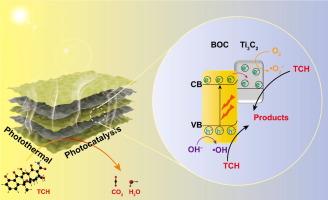Tuning interfacial charge transfer for efficient photodegradation of tetracycline hydrochloride over Ti3C2/Bi12O17Cl2 Schottky heterojunction and theoretical calculations
IF 6.9
2区 材料科学
Q2 CHEMISTRY, PHYSICAL
引用次数: 0
Abstract
In the ecological environment, tetracycline hydrochloride (TCH) is one of the excessive antibiotics from water, which has watched the eye of researchers. Developing a high-performance photocatalyst to address this phenomenon still faces a big challenge. Herein, we describe a straightforward chemical procedure in-situ self-assembly via one-step solvothermal process to create a new two-dimensional/two-dimensional (2D/2D) Ti3C2/Bi12O17Cl2 heterojunction. The heterojunction at the interface with a strong chemical interaction between Ti3C2 and Bi12O17Cl2 is well revealed by the serial characterizations and theoretical calculations. The superior photocatalytic activity of Ti3C2/Bi12O17Cl2 is attributed to its low recombination rate of electrons and holes, photothermal effect, high electron transfer during reactions and high photochemical current. Finally, the photocatalytic mechanism over Ti3C2/Bi12O17Cl2 is also provided. This work provides an intriguing strategy for the construction of superior photocatalysts for pollutant degradation using MXene as co-catalysts.


调谐界面电荷转移以实现 Ti3C2/Bi12O17Cl2 肖特基异质结对盐酸四环素的高效光降解及理论计算
在生态环境中,盐酸四环素(TCH)是水中超标的抗生素之一,一直受到研究人员的关注。针对这一现象开发高性能光催化剂仍面临巨大挑战。在此,我们介绍了一种简单的化学方法,即通过一步溶解热过程进行原位自组装,从而创建一种新型二维/二维(2D/2D)Ti3C2/Bi12O17Cl2 异质结。通过系列表征和理论计算,Ti3C2 和 Bi12O17Cl2 在界面上的异质结具有很强的化学作用。Ti3C2/Bi12O17Cl2 优异的光催化活性归因于其较低的电子和空穴重组率、光热效应、反应过程中较高的电子转移率以及较高的光化学电流。最后,还介绍了 Ti3C2/Bi12O17Cl2 的光催化机理。这项工作为利用 MXene 作为助催化剂构建用于污染物降解的优质光催化剂提供了一种有趣的策略。
本文章由计算机程序翻译,如有差异,请以英文原文为准。
求助全文
约1分钟内获得全文
求助全文
来源期刊

Applied Surface Science
工程技术-材料科学:膜
CiteScore
12.50
自引率
7.50%
发文量
3393
审稿时长
67 days
期刊介绍:
Applied Surface Science covers topics contributing to a better understanding of surfaces, interfaces, nanostructures and their applications. The journal is concerned with scientific research on the atomic and molecular level of material properties determined with specific surface analytical techniques and/or computational methods, as well as the processing of such structures.
 求助内容:
求助内容: 应助结果提醒方式:
应助结果提醒方式:


